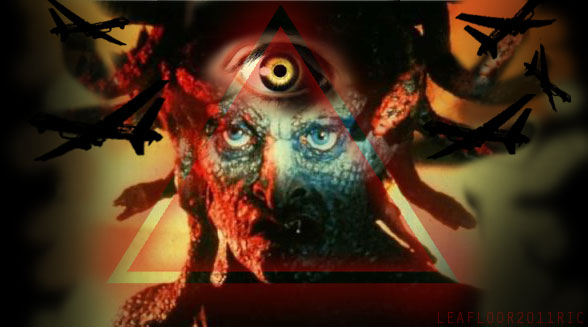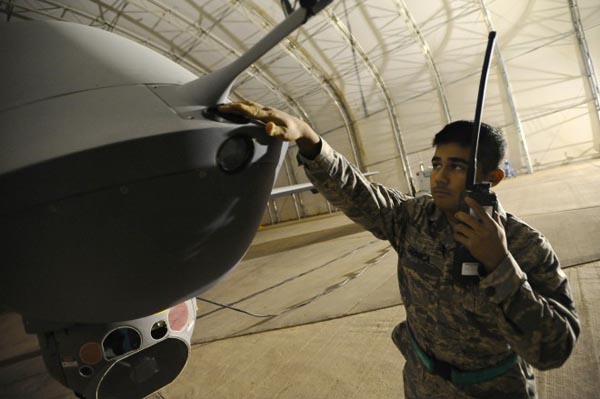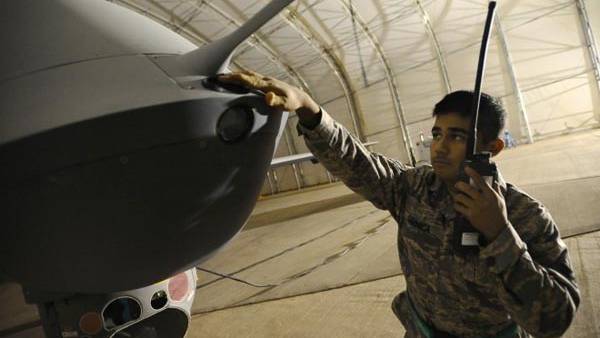Air Force’s ‘All-Seeing Eye’ Flops Vision Test
Source: wired.com

It’s the one of the most revolutionary — and one of the most chilling — weapons to come out of America’s decade of conflicts in Afghanistan and Iraq. Gorgon Stare, a new “all-seeing” camera system for aerial drones, is supposed to boost U.S. surveillance by an order of magnitude, by installing a hive of nine or more cameras under the wing of an Air Force Reaper drone. Gorgon Stare-equipped Reapers are meant to watch over a “city-size” area, while also simultaneously sending video feeds to dozens of “customers” on the ground.

There’s just one problem. Gorgon Stare doesn’t work as promised, at least according to the Air Force squadron whose job it is to test the new system.
In a draft report dated Dec. 30 and obtained by rogue military analyst Winslow Wheeler, the 53rd Wing at Eglin Air Force Base in Florida declared Gorgon Stare “not operationally effective” and “not operationally suitable.” Alleged problems include poor-quality video, glitches in the process for downloading video streams, and a small problem of the drone blinding itself with a laser.
This is bad. Real bad. The Air Force is counting on Gorgon Stare to help its squadrons in Afghanistan meet “insatiable” demand for overhead full-motion video.
Despite steadily adding drones — there are now more than 50 three-’bot “orbits” deployed in Iraq and Afghanistan — the supply is never adequate. “It’s like crack, and everyone wants more,” Army Brig. Gen. Kevin Mangum said of drone-supplied video.
Equipping a portion of its drone fleet with Gorgon Stare would be like adding hundreds of new drones, from the perspective of the soldier on the ground. Now, the Air Force might not get that boost.
A standard drone spycam takes a “soda straw” view of what’s beneath, focusing on a lone vehicle or a single home at a time. Gorgon Stare, on the other hand, uses a bundle of cameras, each one shooting at a very slow rate and at a slightly different angle. That allows the sensor to watch over a much larger area at once: about 36 square miles or so, according to some estimates.
“Gorgon Stare will be looking at a whole city,” Air Force intelligence chief Maj. Gen. James Poss recently told The Washington Post. “We can see everything.”
But that view might not be so clear. The 53rd Wing found 13 serious deficiencies in the system. To carry the Gorgon Stare pod plus the required processing pod, Reapers have to be stripped of other sensors and weapons and structurally reinforced. The layout of the underwing pod puts it in the way of the Reaper’s nose-mounted ranging laser, meaning Reaper remote pilots could accidentally “lase” and blind their own cameras.
Even when working correctly, the Gorgon Stare’s cameras are ”marginally sufficient to track vehicles” but “not sufficient to track dismounts [people],” the testers wrote. “In general, IR [infrared] imagery quality is poor, which yields marginal mission capability at night.”
Plus, soldiers on the ground could have a hard time capturing the Gorgon Stare’s video feed. Even if they do, a glitch in the system means imagery is “subject to gaps between stitching areas [where the camera images meet], which manifests itself as a large black triangle moving throughout the image.”
Gorgon Stare “cannot reliably find and track human targets; it has additional problems for moving targets, and the random location inaccuracy makes the system virtually unusable for prosecuting even stationary targets,” Wheeler summed up in an e-mail.
Gorgon Stare and other “wide-area airborne surveillance” (WAAS) systems came out of an Iraq-war imperative to track car bombs across an entire city. Spycams might not be able to prevent such attacks. But if a whole town could be surveilled at once, the car bombs could be traced back to their points of origin.
As the insurgency evolved, and the Afghanistan conflict heated up, the need for WAAS changed. Instead of spotting vehicles after the fact, the military wanted WAAS to find individual, dismounted attackers — in real time.
But with a resolution at least twice as bad as standard drone cameras — and a frame rate of just 2 per second, compared to 30 in standard-issue spycams — tracking individual militants might be too tough a mission for a WAAS system. “If somebody said Gorgon Stare could spot dismounts, they probably oversold it,” says a source familiar with the programs. “It was not designed to do that.”
The 53rd Wing recommended more testing and development before Gorgon Stare gets installed on Reapers in Afghanistan, something that is supposed to happen “this winter.”
We’ve asked the Air Force to respond to this report. We’ll let you know what they say.
Now, to be fair, tests are designed to uncover problems, not just rubber-stamp things that already work fine. And military testers are paid to be skeptics and trained to find even the tiniest glitch in new weapons.
That can result in unfair assessments of urgently needed weapons — and sometimes leads to clashes between testers and the broader Pentagon establishment. For example, testers for years declared the Navy’s EA-18G radar-jamming plane “not operationally suitable,” but the Pentagon pressed ahead with — and even expanded — plans to field the jet.
Similar assessments were made of the now-iconic Predator drone back in October 2001, when the testers found it to be not “operationally effective or suitable.” It wasn’t long before the robotic spy plane was making important contributions to the war in Afghanistan.
The 53rd Wing’s assessment of Gorgon Stare could be an example of over-stringent testers striving for unnecessarily lofty benchmarks. Or the Air Force testers are correct, and the Pentagon’s revolutionary all-seeing eye really is blurry and half-blind.
Update 7:11pm: “Gorgon Stare is in the first increment of a multi-increment program, and the second increment will increase the warfighter’s capabilities by range and resolution,” Air Force spokesman Lt. Col. Richard Johnson says in a statement, released moments ago.
The document leaked was a draft memo that was later revised in January.
The January memo includes three issues that we have identified and have fixes in place. The first was addressing critical Technical Order shortfalls; the second was Gorgon Stare Ground Station image and grid coordinate generation; and the third was Remote Video Terminal compatibility. We’re working all three issues and do not believe they will affect the deployment schedule.
Air Force leadership understands the importance of providing quick, timely and actionable ISR for the field. Gorgon Stare will not be fielded until the theater commander accepts it.
The Air Force takes its responsibility seriously because lives depend on the quality of the intelligence products that are produced.
Photo: USAF
Article from: wired.com






















